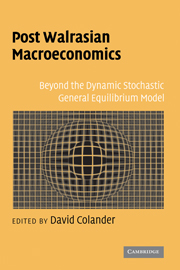Book contents
- Frontmatter
- Contents
- List of Contributors
- Foreword by Alan Kirman
- Introduction
- PART I WHERE WE ARE IN MACRO AND HOW WE GOT THERE
- 1 Episodes in a Century of Macroeconomics
- 2 Post Walrasian Macroeconomics: Some Historic Links
- 3 The Problem of Time in the DSGE Model and the Post Walrasian Alternative
- 4 Who Is Post Walrasian Man?
- PART II EDGING AWAY FROM THE DSGE MODEL
- PART III LEAPING AWAY FROM THE DSGE MODEL
- PART IV LETTING THE DATA GUIDE THEORY
- PART V POLICY IMPLICATIONS
- Bibliography
- Index
4 - Who Is Post Walrasian Man?
Published online by Cambridge University Press: 02 December 2009
- Frontmatter
- Contents
- List of Contributors
- Foreword by Alan Kirman
- Introduction
- PART I WHERE WE ARE IN MACRO AND HOW WE GOT THERE
- 1 Episodes in a Century of Macroeconomics
- 2 Post Walrasian Macroeconomics: Some Historic Links
- 3 The Problem of Time in the DSGE Model and the Post Walrasian Alternative
- 4 Who Is Post Walrasian Man?
- PART II EDGING AWAY FROM THE DSGE MODEL
- PART III LEAPING AWAY FROM THE DSGE MODEL
- PART IV LETTING THE DATA GUIDE THEORY
- PART V POLICY IMPLICATIONS
- Bibliography
- Index
Summary
In his introduction to this volume, David Colander identifies information as the source of differences in the Walrasian and Post Walrasian approaches to macroeconomics. Walrasians, we are told, assume that economic agents are superior “processors” who live in “information rich” environments, whereas Post Walrasians believe that agents must struggle to make sense of an information poor world. As a consequence, Colander advocates that the Walrasian “holy trinity” of rationality, equilibrium, and greed be replaced with purposeful behavior, sustainability, and enlightened self-interest.
But are these catchphrases little more than slogans? Kevin Hoover (this volume) is concerned that Colander's “beautiful words … are a kind of free verse” and that “[even if we do not] know more about the economy from hewing to the structures of Walrasian economics … there is something to be said for discipline.” I want to argue that this concern is misplaced, that a commitment to the Post Walrasian enterprise is not a recipe for incoherence. Indeed, more than their Walrasian brethren, Post Walrasians have allowed experimental and other new sources of data to “discipline” their research, and are dedicated to the articulation of game theoretic and other theoretical models that rationalize this data. The conception of economic man embodied in Colander's “beautiful words,” which shares some similarities with Samuel Bowles and Herbert Gintis' homo reciprocans (Bowles and Gintis, 2000) and with Alan Kirman's (1997) characterization of economic man as an interactive agent, is not an amorphous one.
- Type
- Chapter
- Information
- Post Walrasian MacroeconomicsBeyond the Dynamic Stochastic General Equilibrium Model, pp. 80 - 94Publisher: Cambridge University PressPrint publication year: 2006



